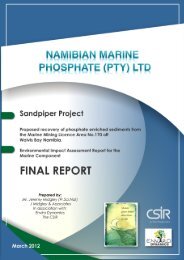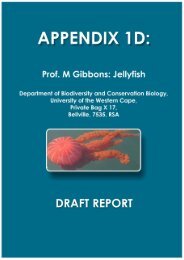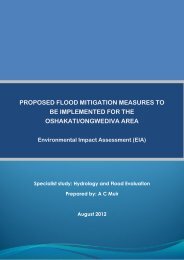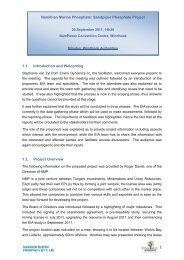Fisheries - Enviro Dynamics Namibia
Fisheries - Enviro Dynamics Namibia
Fisheries - Enviro Dynamics Namibia
You also want an ePaper? Increase the reach of your titles
YUMPU automatically turns print PDFs into web optimized ePapers that Google loves.
F I S H E R I E S , M A M M A L S A N D S E A B I R D S S P E C I A L I S T S T U D Y<br />
/ subtropical offshore habitats (elsewhere in the world) and would therefore be more likely to<br />
occur (if at all) both further offshore and in the more northerly extent of <strong>Namibia</strong>n waters, than<br />
the cold temperate conditions characterising the <strong>Namibia</strong>n coast. Stranding or skeletal records of<br />
southern bottlenose whales, rough toothed dolphin and Gervais’ beaked whale have been<br />
recorded from the <strong>Namibia</strong>n coast, although the level to which these may be extra-limital records<br />
is unknown. There are no data on the population status of these species off the southern African<br />
coast.<br />
The main species characteristics and relevance to the MLA are outlined herewith and also listed<br />
in Appendices 1a – 2 and 3.<br />
4.3.2 Mysticete (baleen) whales (Appendix 1a - 2)<br />
Blue whales : Two forms of blue whales are recorded from the Southern Hemisphere. Antarctic<br />
or true blue whales (Balaenoptera musculus intermedia) migrate from summer feeding grounds<br />
within the southern ocean (near the Antarctic ice edge) to winter calving grounds in temperate<br />
waters, although little is known of their definite destination in winter (Mackintosh 1966). Pygmy<br />
blue whales (B. m. brevicauda) are recorded from the southern Indian Ocean. Harmer (1931)<br />
noted on the basis of the peak of the catches being sharper off Moçamedes (now Namibe),<br />
Angola, than Walvis Bay, <strong>Namibia</strong>, that Angola was closer to the northern point of the blue whale<br />
migration than Walvis Bay. The seasonality of catches of blue whales from the southern African<br />
west coast suggests that the majority of blue whales migrate northwards through southern<br />
<strong>Namibia</strong>n waters between May and July to Angolan waters (July and August) and return<br />
southwards after August.<br />
Although no offshore distribution patterns were recorded off <strong>Namibia</strong>, catches of blue whales in<br />
waters 65 to 95 kilometres offshore of the South western Cape coast of South Africa suggest that<br />
the migration occurs off the continental shelf slope (in waters of depths of between 2000 and<br />
3500 metres). Furthermore, catches of blue whales off the southern Africa west coast generally<br />
occurred after catches of humpback whales which suggest that blue whales occurred in offshore,<br />
deeper waters than humpback whales. Olsen (1915) however noted that off the Western Cape,<br />
large schools moved inshore from the north between June and August.<br />
Blue whales are unlikely to pass in or near the MLA<br />
Fin whales (B. physalus) : Like blue whales, little is known of the winter migration destinations of<br />
fin whales. Gambell (1985) noted that fin whale migrations occur after blue whale migrations, but<br />
precede those of sei whales. Harmer (1931) reported that catches off the Western Cape had a<br />
bimodal distribution (with maxima in May – July and October – November). Fin whales have been<br />
recorded in catches from Walvis Bay and Angola (Harmer 1929), and off Gabon in 1934 (Budker<br />
and Collignon 1952), and although no seasonal maxima are provided, these records show<br />
migrations to the north of the Western Cape.<br />
If the shelf edge is taken as 200 m, most of the fin whales should pass inshore of the mining area.<br />
Although the offshore distribution of fin whales in southern <strong>Namibia</strong> is unknown, there is some<br />
suggestion that the species migrates along the continental shelf edge (Macintosh 1966).<br />
Final Report<br />
<strong>Namibia</strong>n Marine Phosphate (Pty) Ltd.<br />
Page 37

















